You've seen bridges all over the world loaded with love locks. Engraved with initials or messages to friends, family and loved ones, love locks are still a classic sign of love, even in the digital age. Adding love locks to a bridge can be part of some of your bucket lists, while many of you may have already crossed it.
But while a simple glance at a love-locked bridge can give you romantic feelings, there is a not-so-romantic truth behind them. Millions of love locks on a bridge or fence increase the weight, making it dangerous to be anywhere near it. Some cities around the world have got rid of these locks, so that the landmark bridges remain safe. Other cities are looking at adding locks purely as vandalism.
So which loving couple or star-crossed lovers started this trend that will span generations to come? What is the symbolism behind the lock? And who noticed a tiny lock on a bridge or a fence and imitated the action? Let's see here.
What are love locks?

A love lock is a simple padlock that two partners attach to a landmark such as a fence, a bridge, a monument or even a tree. The couple then follow the tradition of throwing the key to symbolize their eternal love, which can not be broken. Usually couples dig their initials or messages on the padlock. Sometimes it is the date that is engraved. Whatever it is, it is something that is symbolic of the couple or person who associates it with the landmark. The key is usually thrown into a nearby body of water.
In the early 2000s, there has been an increase in the practice of adding love locks. Some places and landmarks around the world have become famous for the millions of padlocks that have been added to them. However, some cities and municipalities treat them more like a nuisance or vandalism. It costs quite a bit to get them removed. On the other hand, some city officials consider them part of modern culture and use them as tourist attractions or fundraising projects.
A Serbian story of love ... or heartache?
The origins of the history of love locks are most often attributed to Paris, or more specifically, the original padlock loaded Pont Des Arts Bridge in Paris. Why not, since Paris is considered one of the most romantic cities in the world?
But no, Paris is not where it all began. It actually began in a small town in Serbia called Vrnjačka Banja in 1914, when World War I was about to break out. Young men were called to fight in the front lines in what seemed like a hopeless battle. One such man was Relja, a Serbian officer. Like the many stories where men leave their girlfriends and go to war, Relja had to do the same. His girlfriend was a schoolteacher named Nada.
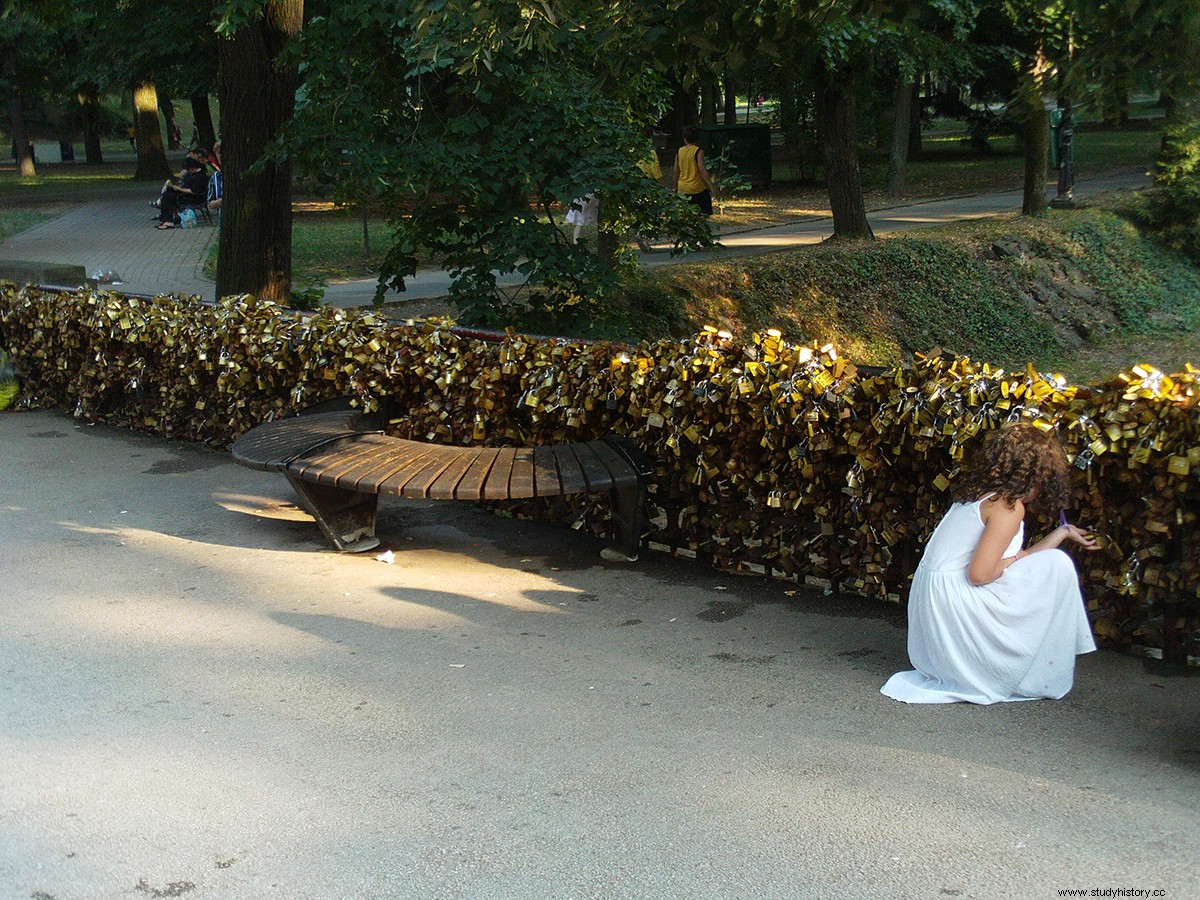
Inseparable, young and in love, they quickly become engaged, with dreams of eternal love and a family. But one of life's often cruel ironies was just around the corner, when Relja had to leave the war. A miserable Nada lived in the city and thought that her love would return, just as he promised. But Relja never returned to Vrnjačka Banja. He fell in love with a woman in Corfu while at war. A broken Nada fell into depression when she received the news of her broken engagement, and it is said that she died of a broken heart, young and alone.
Nor did the tragic story go unheard in the city. The other young women were worried about the incident. What they did to ensure the immortality of their own romances was what started the action that would span for centuries to come. The young women of Vrnjačka Banja bought hundreds of padlocks en masse. They wrote their names and girlfriends on the locks before attaching them to a bridge that served as Nada and Relja's regular meeting point. The keys were then thrown into the river to ensure loyalty.
As the years passed, the story of Nada and Relja slowly faded into the background and was forgotten. It was not until Desanka Maksimović, the Serbian poet, brought it back to light with her poem, Molitva za ljubav (Prayer for Love). Thanks to the poem, the story caught fire and star-crossed lovers all over the city began to attach love locks to a footbridge. The bridge was soon named Most ljubavi or Love of Bridge.
A popular trend
The tradition was soon copied by cities around the world, some more than others. Cities like Paris and Barcelona stood out for the millions of love locks attached to their bridges. But these cities would eventually be forced to cut the locks with bolt cutters as the bridges were threatened with the weight of millions of locks. However, this does not deter the few daring individuals who still brought and used beloved locks on the bridges. The rest of Europe saw the spread of love locks in the early 2000s. The reasons varied, as did the places.
While the rest of the world had its own reasons for using love locks, southern Serbia believed in its own set of superstitions. The locks attached to the Bridge of Love have never been removed. Although there are over fifteen bridges in the town of Vrnjačka Banja alone, no one can be mistaken for the legendary bridge that captured the hearts of millions of people around the world.
Unlocking the locks
As the use of love locks spread like wildfire around the world, local authorities have often removed them. The reasons vary from security issues to preserving the legacy, as we will see from the examples I have cited here.
Canada
A woman in Winnipeg, Canada, was seriously injured when she cycled over a lock. A love lock caught her arm. The injury led to a trip to the emergency room to get 21 stitches.
The Wild Pacific Trail in Ucluelet on Vancouver Island has resulted in some controversy about the love locks attached along the trail. The complaint is that the locks act as an unwanted distraction from nature.
The Humber Bay Arch Bridge in Toronto has removed love locks. The reasons mentioned were aesthetics and the structural concern if the bridge became a destination for attaching love locks.
Australia
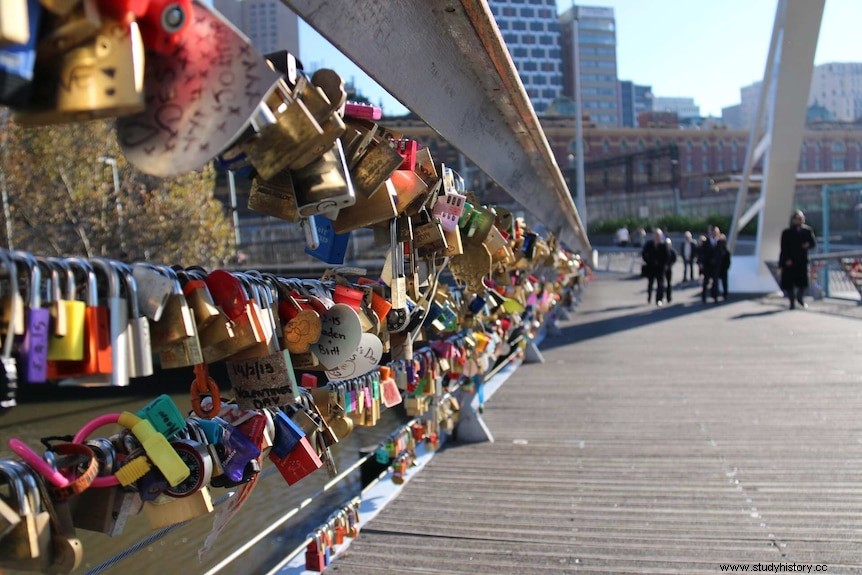
In February 2015, in Canberra, Australia, the authorities took matters into their own hands by removing love locks from a bridge that became a popular place to fasten the locks. Locks were also removed from various other places in Canberra. The authorities acted out of concern due to the possibility of future threats to public safety. A large number of locks can lead to overloading of the bridge. Corrosion due to structural disturbance was an additional problem.
Two months later that year, councilors began removing love locks from the Southgate footbridge in Melbourne. It was over security considerations. Reports claim that nearly 22,000 XNUMX love locks were attached to the railing, causing the cables to fall.
Picnic Point in Toowoomba is a heritage site with a park and a vantage point at the top of the Great Dividing Range. Authorities are concerned about the growing number of love locks attached to the site.
United States
From 2015-2017 in Norfolk, Virginia, residents removed hundreds of love locks from a footbridge over the Hague inlet in Ghent. Afterwards, they went to Norfolk Circuit Court and forced Norfolk City Council to remove the rest of the love locks. Citizens no longer wanted to fasten love locks. Virginia law views locks as illegal obstacles in a right of way. Anyone using Virginia law had the right to remove such barriers.
In 2013, a group of locksmith enthusiasts in New York organized to remove love locks from the Brooklyn Bridge (Locksport enthusiasts learn skills such as lock picking, locking, and other skills traditionally known only to locksmiths and other security guards.)
At the Paris Hotel in Las Vegas, there is a 1/2 scale model of the Eiffel Tower on the Las Vegas Strip. Visitors place love locks on the walkway to the elevators. However, they are ordered not to throw the keys from the tower. To put this into practice, the lobby sells open locks without keys.
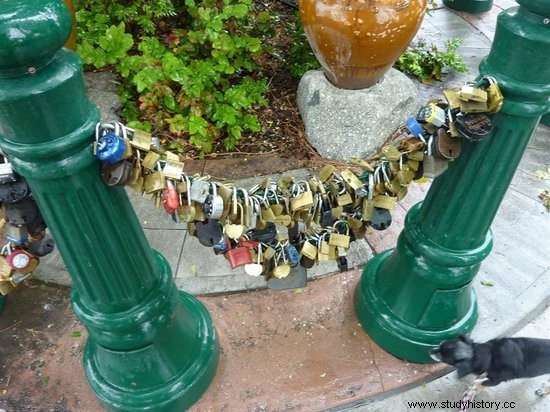
There are cases in the United States where love locks retain their romantic symbolism. Canfield, Ohio, in 2014 saw the installation of BIG LOCK at Canfield Fairgrounds as a community project. Visitors can attach a personal lock to a 12 ′ x 12 ′ steel cage faucet built for the purpose.
In Nevada, people are encouraged to add locks to chains that are attached between the posts at Lover's Lock Plaza in Lovelock. The name of the city is not related to the practice. The town is named after the family who settled on the site during the 1860s. The practice of adding locks only came up much later.
In San Angelo, the city drew inspiration from the Paris Bridge and erected a sculptor known as 'Forever Love'.
In 2011, a lover's bridge was created in Discovery Bay, Northern California. Carolyn and Anthony George got married 11-11-11 and took inspiration from the movie Now You See Me, and created a place for a couple to be locked in love. The couple fastened love locks and wanted to throw the keys in the California Delta waterways around Discovery Bay.
France
Perhaps the most famous controversies about love locks are those at the Pont des Arts, the Passerelle Léopold-Sédar-Senghor and the Pont de l'Archevêché bridges. In 2010, the city expressed concern about the growing number of locks attached to these bridges, stating that they raised issues for the preservation of the city's architectural heritage.
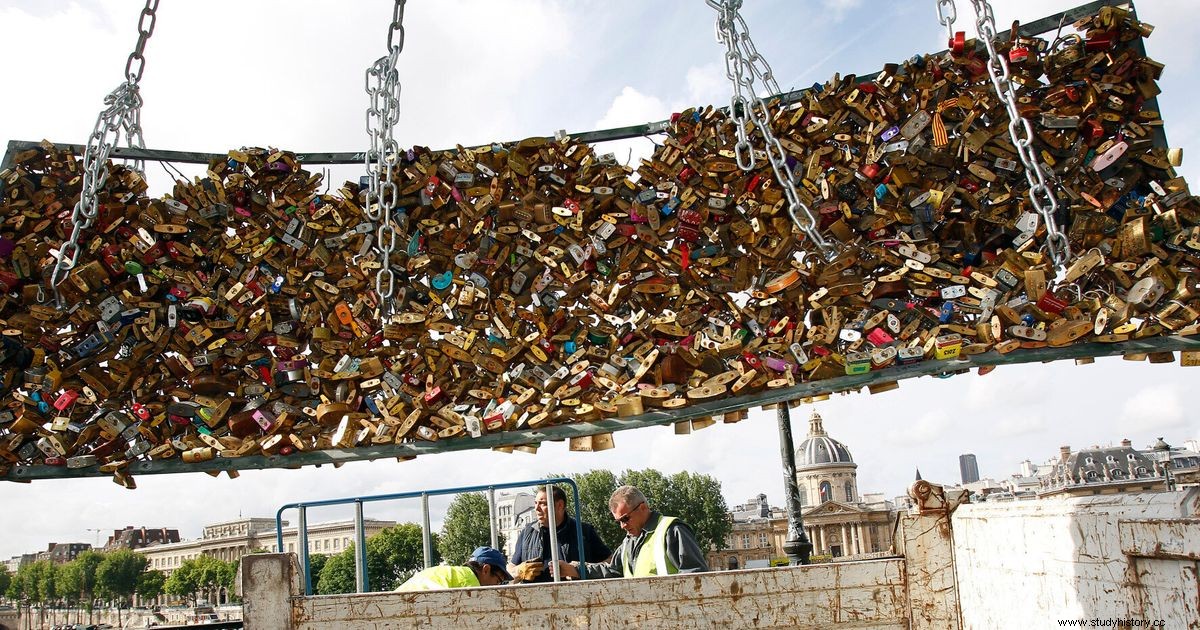
During the night of May 11 th In 2010, many of the locks on the Pont des Arts disappeared. They were removed by a student from the École des Beaux-Arts to create a sculpture. However, locks immediately began to appear on the Pont de l'Archevêché, as it spread to at least eleven Seine bridges, the Canal Saint-Martin footbridges and to monuments and parks around the city. Many tourists who flock to the city believe that this practice originated in Paris, but the truth is that the love-locking tradition only migrated here towards the end of 2008.
In January 2014, two Americans living in Paris launched a campaign and a petition, No Love Locks ™, to save Paris' bridges and monuments. The campaign received international attention. In the summer and autumn of the same year, the city began to look for alternatives to the locks. The public was asked to stop attaching locks to bridges and monuments.
At 9 th In May 2014, when part of the parapet on the Pont Des Arts Bridge collapsed, the locks were blamed. In September, three panels on the bridge were replaced with a special type of glass that prevented locking. In June 2015, the collapse of the bridge led to the locks being removed.
Italy
The city of Florence removed thousands of love padlocks attached to the Ponte Vecchio bridge by the city council. The Council claimed that the locks, in addition to being an aesthetic problem, also caused scratches and dents in the bromo metal.
Venice is one of the cities where it is strictly forbidden to add locks to bridges. This is especially enforced on the city's Rialto Bridge, where you can be fined up to € 3,000 if you add a love lock.
Japan
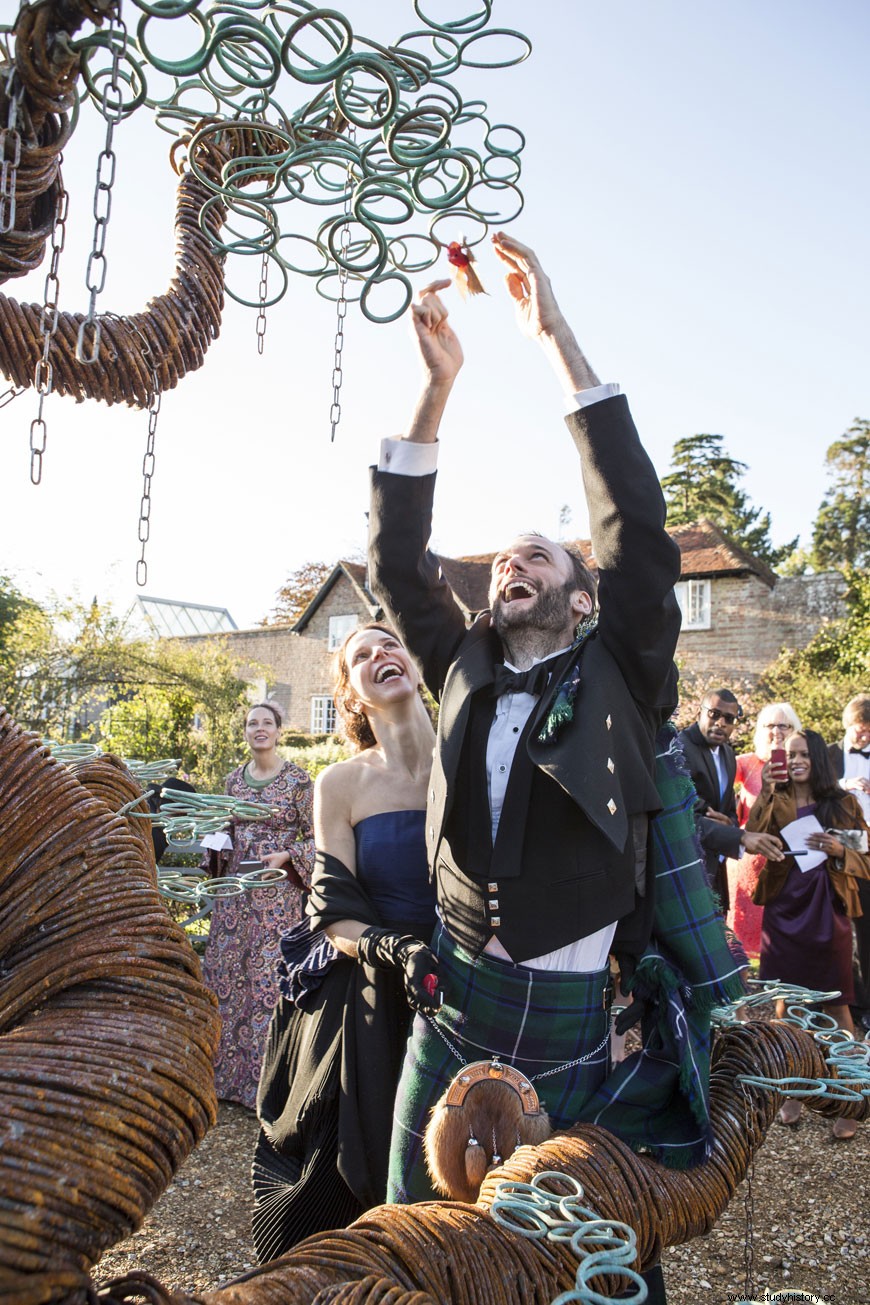
Jonathan Montagu and Nathalie Daoust are a couple who met in Japan. To celebrate the meeting and the love, they commissioned Claire Grotefeld, an artist, to design and make a large bonsai love tree. The tree was designed for their wedding in October 2014. The tree is now located at Beaulieu Palace House, UK, and couples are invited to add their own love locks, thus helping the tree to blossom.
Legends about love locks
In some places, love locks have acquired legendary features.
In Fengyuan, Taiwan, they are attached in pairs when locks are added to a transition at the train station. The locks have become known as the desired locks. According to local legend, when trains pass under, they generate a magnetic field that will cause energy to accumulate in the locks, thus fulfilling their desires.
In Uruguay, there is a fountain in Montevideo with a plaque attached to the front. The album has an explanation in both Spanish and English. The English version says that when two people put a lock with the initials in the fountain, they will remain together and their love will be locked forever.
the conclusion
While many cities cling to the old love story and symbolism of love locks, other cities see them only as a nuisance, a risk or as vandalism. Many others see them as today's culture or heritage. No matter how you look at them, there is no denying that they are universal symbols of love, commitment and strength.
